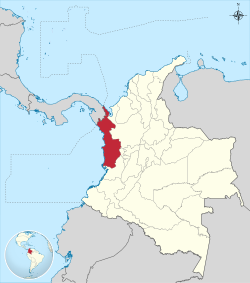Choco Department
|
Department of Chocó Departamento de Chocó |
|||
|---|---|---|---|
| Department | |||
|
|||
 Chocó shown in red |
|||
 Topography of the department |
|||
| Coordinates: 5°42′N 76°40′W / 5.700°N 76.667°WCoordinates: 5°42′N 76°40′W / 5.700°N 76.667°W | |||
| Country |
|
||
| Region | Pacific Region | ||
| Established | November 3, 1947 | ||
| Capital | Quibdó | ||
| Government | |||
| • Governor | Jhoany Carlos Alberto Palacios Mosquera(2016-2019) | ||
| Area | |||
| • Total | 46,530 km2 (17,970 sq mi) | ||
| Area rank | 9th | ||
| Population (2013) | |||
| • Total | 490,327 | ||
| • Rank | 23rd | ||
| • Density | 11/km2 (27/sq mi) | ||
| Time zone | UTC-05 | ||
| ISO 3166 code | CO-CHO | ||
| Municipalities | 30 | ||
Chocó is a department of Colombia known for its large Afro-Colombian population. It is in the west of the country, and is the only Colombian department to have coastlines on both the Pacific Ocean and the Atlantic Ocean. It also has all of Colombia's border with Panama. Its capital is Quibdó.
Chocó has a diverse geography, unique ecosystems and unexploited natural resources. However, its population has one of the lowest standards of living of all Departments in Colombia. In March 2007 Colombian media reported that some 50 children starved in less than three months, creating awareness of the grave condition Chocó inhabitants are facing. Infrastructure problems were also revealed. For example, despite its status as the world's rainiest lowland, with close to 400 inches of annual precipitation, Chocó's capital Quibdó was left without drinking water.
The Department was created in 1944 being speaker at House of Representatives Pedro Yances Salcedo, but it was never legally established. Due to its low population, inhospitable topography, and distance from Bogotá, Chocó has received little attention from the Colombian government. During the government of military dictator Gustavo Rojas Pinilla Chocó was to be eliminated as a department and divided between Antioquia department and Valle del Cauca department, but Pinilla's intentions were thwarted by the 1957 coup d'état of General Gabriel París Gordillo.
The Chocó Department makes up most of the ecoregion known as El Chocó that extends from Panama to Ecuador.
The municipality of Lloró holds the Highest Average Annual Precipitation record measured at 523.6 inches (13,300 mm) which makes it the wettest place in the world. Three large rivers drain the Chocó Department, the Atrato, the San Juan and the Baudó, and each has many tributaries. The Baudó Mountains on the coast and the Cordillera Occidental are cut by low valleys with an altitude less than 1,000 meters that form most of the territory. Most of the Chocó is thick rainforest. Much of Colombia's internal consumption of wood come from the Chocó, with a small percentage harvested for export.
...
Wikipedia


